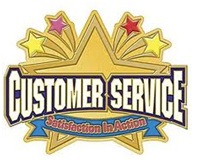|
 |
|
 |
Change management
Making changes in an organization’s 7 S’s (strategy, structure, systems, staff, skills, style of management and shared values) to improve customer satisfaction.
How to manage change
1. Think of the customer Any change must help to satisfy customers better through motivated employees working effectively in teams. Don’t be afraid to make big changes (revolution) as well as small improvements (evolution or incremental change). Revolutionary (or transformational) change is more necessary, when competition and innovation are high (e.g. computer software). Ask employees for some ideas about how to improve customer service, because some of them (sometimes called front line employees) will deal directly with the public.
2. Win people over People normally hate change, because they like the way things have always been done (the status quo). They get lazy and complacent in the comfort zone. Often a third of people will support change, a third can be persuaded and a third will always oppose it. This opposition must be overcome, so that everyone is fully motivated and empowered to make the change work – how?
a) great leadership Bosses and senior managers must:
b) reward people who change (e.g. more money and interesting work – see point 3).
c) involve employees
Telling people what to do can be effective (particularly in a crisis) but can also produce fear and resistance to change.
d) empowerment Encourage people to take responsibility for results, so they have the self-motivation and self-belief to change themselves.
e) unity of effort Make sure everyone enthusiastically supports the change by emphasizing its common benefits. Disunity will result from unfair treatment.
f) be challenging but realistic Stretch people but don’t give them expectations that can’t be delivered.
g) avoid fad fatigue
3. Make change as easy and attractive as possible The organization must value, encourage and reward people who change. So give them:
4. Make change last Every employee must love improving for customers, being positive and avoiding the fear of failure. So corporate culture is vital in which everyone values improvement and automatically puts it into action. Change is an attitude of mind and so people must change before the organization can. But be patient – cultural change (changing attitudes) can take as long as 10-15 years! So keep on supporting the change strategy with the money it needs.
5. Speed Introduce change as quickly as you can to keep ahead of competitors without demotivating employees So change is most effective when it comes voluntarily from self-motivated people.
6. Know what, how and when to change Be prepared to change everything you do but realize there has to be a good reason for changing (e.g. beating competitors). Sometimes doing little or nothing may be best, but this is unlikely in today’s rapidly changing world. So any change strategy must constantly:
Key quotes explained
“Every organization has to prepare for the abandonment of everything it does”, - Peter Drucker (American management writer, pictured right). Successful organizations must be capable of changing completely, even though it is painful and things are going well. “The time to repair the roof is when the sun is shining”, said John F. Kennedy, the American president.
“Change is an attitude of mind and the place to start is within ourselves”, - John Harvey-Jones (ex-boss of the British chemicals company, ICI, pictured right). Change comes from people’s attitudes (“You must become the change you see in the world”, Gandhi said). So, if employees don’t want to change, the organization won’t change.
“The test of a first rate intelligence is to hold two opposite ideas in mind at the same time and still retain the ability to function”, - Scott Fitzgerald (American novelist, pictured right). Ideas about change often come from a combination of opposites (e.g. high quality and low prices) and paradox (e.g. being tough to be kind). So an important job of a leader or manager is to deal with ambiguity (i.e. conflicting ideas). Fitzgerald’s idea is similar to “doublethink” in George Orwell’s novel, 1984 (holding two contradictory beliefs simultaneously and accepting both of them). The Greek philosopher, Heraclitus, also
reminds us that “Change is permanent and opposites may be different routes to the same
solution”.
“When people feel the wind, some build windmills and some build walls, - Chinese proverb. Some people use change to their advantage, whilst others resist it. To succeed you must find solutions to the problems thrown up by constant change. “When you’re finished changing, you’re finished”, the American politician and inventor, Benjamin Franklin (pictured right), said.
“There are no gains without pains” - Adlai Stevenson (American politician, pictured right). Change is painful, but its fruits are sweet, particularly if you have faith in the future. “There can be no progress if people have no faith in tomorrow”, John F. Kennedy said.
Best books and articles
Richard Pascale (pictured right) , Managing on the Edge (1990) Successful change comes from: • Hating complacency: the best organizations see success as the springboard to even greater success and realize that success can easily turn into failure (so Intel’s ex-boss, Andy Grove, said “Only the paranoid survive”) • Creativity - from constructive conflict (or disagreement with common aims) and challenging existing ways of thinking. (see for more detail Managing on the Edge in the Business Books section)
Michael Hammer (pictured right) and James Champy (pictured right below), Reengineering the Corporation (1993) They invented the term “reengineering” (sometimes called BPR, business process reengineering) which requires a major re-thinking and re-designing of an organization’s key processes. These are:
a) production (from purchasing to distribution to customers).
b) customer engagement (from finding customers to getting their order).
c) order fulfilment (from order to delivery and payment).
d) customer service (from customer enquiry to answering it).
e) product development (from idea to prototype).
Radical (or revolutionary) change is needed not just small (or incremental) change. Forget the past and re-build an ideal organization from scratch that can give the best service to present and future customers with the help of IT. But in the 1990’s three quarters of reengineering programmes failed because of poor leadership and a demoralized workforce, caused by an over-emphasis on redundancies and cost cutting.
Michael Beer (pictured right), Russell Eisenstat and Bert Spector, Why Change Programmes Fail (1990 Harvard Business Review article).
Successful change in the organizations they studied didn’t come from change strategies led by the chief executive but from less senior managers, encouraged by the chief executive to find their own creative solutions to changing customer requirements.
Donald Sull (pictured right), Why Good Companies Go Bad (1999 Harvard Business Review article) Some companies suffer from “active inertia” i.e. resistance to change and wanting to do things the way they’ve always been done.
Peter Drucker (pictured right), Management Challenges for the Twenty First Century (1999) The best organizations are change leaders who stay ahead of change by:
Lou Gerstner (pictured right), Who Says Elephants Can’t Dance (2002) As IBM’s chief executive, Gerstner transformed its profits by:
He particularly valued his research staff, realizing that IBM’s technological expertise was its main advantage over its competitors. Gerstner thought visionary leadership was less important than the successful implementation of change, which was helped enormously by IBM’s financial crisis when he joined in 1993. For more detail see Who Says Elephants Can’t Dance in the Business Books section.
Nassim Nicholas Taleb (pictured right), The Black Swan (2004) A black swan is an event that can’t be predicted on the basis of past experience, making forecasting very difficult (e.g. the Internet, 9/11 and the discovery of black swans in Australia when people thought that all swans were white). For more detail see The Black Swan in the Business Books section.
Leon Festinger (pictured right), A Theory of Cognitive Dissonance (1962) Cognitive dissonance occurs when evidence contradicts your beliefs. To avoid this, people with strong convictions will refuse to change their beliefs and opinions by changing the
evidence to support them. |
|
|
||
|
|
|
||
|
||
| Copyright © wisdomtowin.com All Rights Reserved | ||
|




















